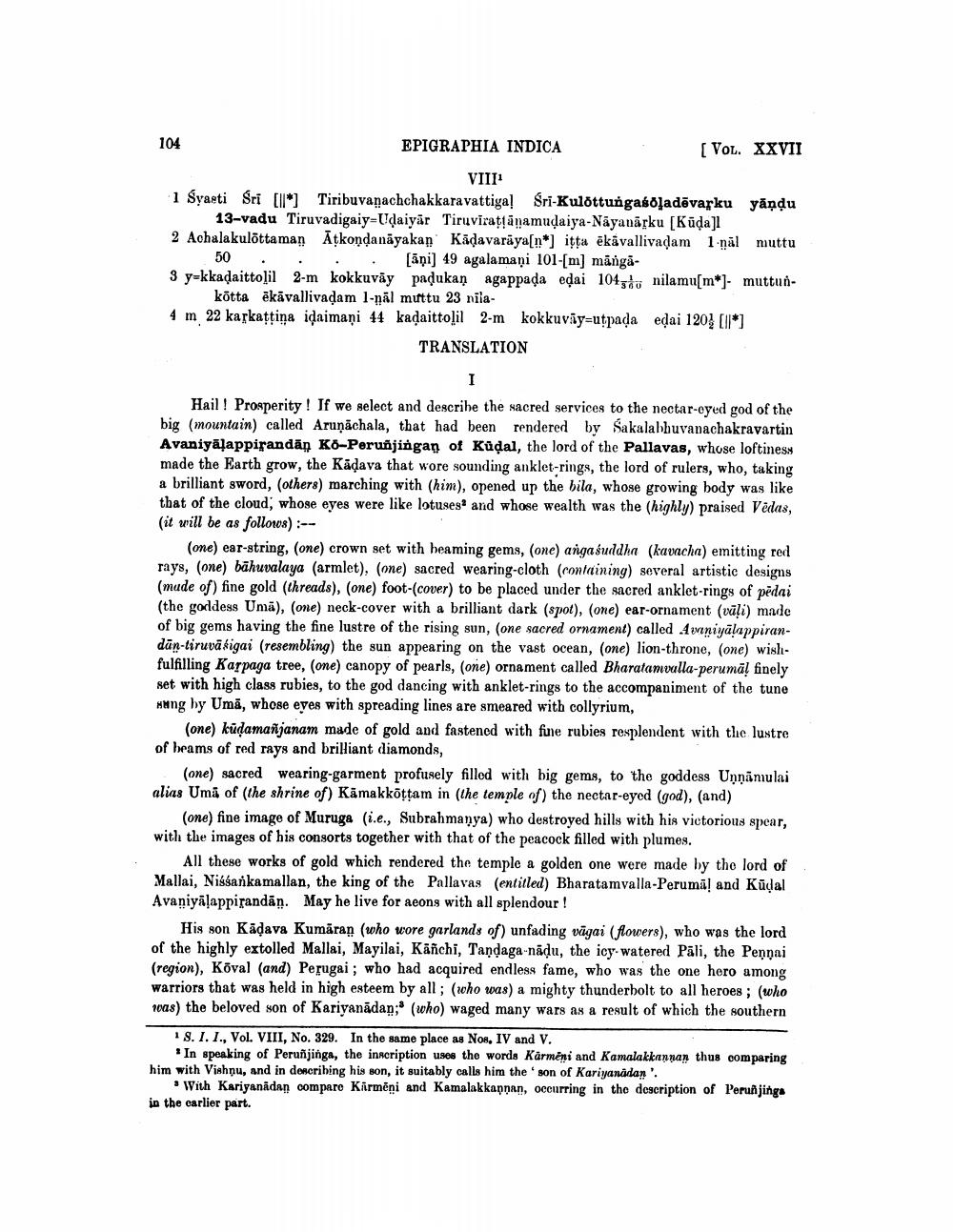________________
104
EPIGRAPHIA INDICA
(Vol. XXVII
VIII 1 Syaeti Sri il Tiribuvaņachchakkaravattiya! Sri-Kulottungasjadēvarku yandu
13-vadu Tiruvadigaiy=Udaiyar Tiruvirattānamudaiya-Nayanarku [Kūda]l 2 Achalakulóttaman Ātkondanāyakan Kādavarāya[n*) itta ēkávallivadam linal muttu
50 . . . . [āņi] 49 agalamaņi 101-[m] māngā. 3 y=kkadaittolil 2-m kokkuväy padukan agappada edai 104 do nilamu[m*]- muttun
kõtta ēkāvallivadam 1-nál muttu 23 nila4 m 22 kaskattiņa idaimaņi 44 kadaittoļil 2-m kokkuvāy=utpada edai 1204 [IT]
TRANSLATION
Hail ! Prosperity! If we select and describe the sacred services to the nectar-eyed god of the big (mountain) called Aruņāchala, that had been rendered by Sakalabhuvanachakravartin Avaniyālappirandan Ko-Perunjingan of Kudal, the lord of the Pallavas, whose loftiness made the Earth grow, the Kādava that wore sounding anklet-rings, the lord of rulers, who, taking a brilliant gword, (others) marching with him), opened up the bila, whose growing body was like that of the cloud, whose eyes were like lotuses and whose wealth was the (highly) praised Vēdas, (it will be as follows) :--
(one) ear-string, (one) crown set with heaming gems, (one) angaśuddha (kavacha) emitting red rays, (one) bāhuvalaya (armlet), (one) sacred wearing-cloth (containing) several artistic designs (made of) fine gold (threads), (one) foot-(cover) to be placed under the sacred anklet-rings of pēdai (the goddess Umā), (one) neck-cover with a brilliant dark (spot), (one) ear-ornament (vāli) made of big gems having the fine lustre of the rising sun, (one sacred ornament) called 4winiyālappirandūn-liruvākigai (resembling) the sun appearing on the vast ocean, (one) lion-throne, (one) wishfulfilling Karpaga tree, (one) canopy of pearls, (one) ornament called Bharatamvalla-perumāļ finely set with high class rubies, to the god dancing with anklet-rings to the accompaniment of the tune Hung by Umā, whose eyes with spreading lines are smeared with collyrium,
(one) kūdamañjanam made of gold and fastened with fue rubies resplendent with the lustre of beams of red rays and brilliant diamonds,
(one) sacred wearing-garment profusely filled with big gems, to the goddess Unnāmulai alias Uma of the shrine of) Kāmakkottam in the temple of the nectar-eyed (god), (and)
(one) fine image of Muruga (i.e., Subrahmanya) who destroyed hills with his victorious spear, with the images of his consorts together with that of the peacock filled with plumes.
All these works of gold which rendered the temple a golden one were made by the lord of, Mallai, Nissankamallan, the king of the Pallavas (entitled) Bharatamvalla-Peruma! and Kūdal Avaniyāļaprirandan. May he live for Aeong with all splendour !
His son Kādava Kumāran (who wore garlands of) unfading vägai (flowers), who was the lord of the highly extolled Mallai, Mayilai, Kanchi, Tandaga nādu, the icy watered Pāli, the Pennai (region), Kõval (and) Perugai; who had acquired endless fame, who was the one hero among warriors that was held in high esteem by all; (who was) a mighty thunderbolt to all heroes; (who was) the beloved son of Kariyanādan;* (who) waged many wars as a result of which the southern
18. I. I., Vol. VIII, No. 329. In the same place as Nos, IV and V.
* In speaking of Peruñjinga, the inscription uses the words Kärmēni and Kamalakkannan thus comparing him with Vishnu, and in dencribing his son, it suitably calls him the son of Kariyanadan.
With Kariyankdan oompare Kirmeni and Kamalakkannan, occurring in the description of Perun jinga in the carlier part.




